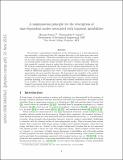A minimization principle for the description of modes associated with finite-time instabilities
Author(s)
Babaee, Hessameddin; Sapsis, Themistoklis P.
DownloadSapsis_A minimizaton principle.pdf (5.371Mb)
OPEN_ACCESS_POLICY
Open Access Policy
Creative Commons Attribution-Noncommercial-Share Alike
Terms of use
Metadata
Show full item recordAbstract
We introduce a minimization formulation for the determination of a finite-dimensional, time-dependent, orthonormal basis that captures directions of the phase space associated with transient instabilities. While these instabilities have finite lifetime, they can play a crucial role either by altering the system dynamics through the activation of other instabilities or by creating sudden nonlinear energy transfers that lead to extreme responses. However, their essentially transient character makes their description a particularly challenging task. We develop a minimization framework that focuses on the optimal approximation of the system dynamics in the neighbourhood of the system state. This minimization formulation results in differential equations that evolve a time-dependent basis so that it optimally approximates the most unstable directions. We demonstrate the capability of the method for two families of problems: (i) linear systems, including the advection–diffusion operator in a strongly non-normal regime as well as the Orr–Sommerfeld/Squire operator, and (ii) nonlinear problems, including a low-dimensional system with transient instabilities and the vertical jet in cross-flow. We demonstrate that the time-dependent subspace captures the strongly transient non-normal energy growth (in the short-time regime), while for longer times the modes capture the expected asymptotic behaviour.
Date issued
2016-02Department
Massachusetts Institute of Technology. Department of Mechanical EngineeringJournal
Proceedings of the Royal Society A: Mathematical, Physical and Engineering Science
Publisher
Royal Society, The
Citation
Babaee, H. and Sapsis, T. P. “A Minimization Principle for the Description of Modes Associated with Finite-Time Instabilities.” Proceedings of the Royal Society A: Mathematical, Physical and Engineering Science 472, no. 2186 (February 2016): 20150779.
Version: Original manuscript
ISSN
1364-5021
1471-2946